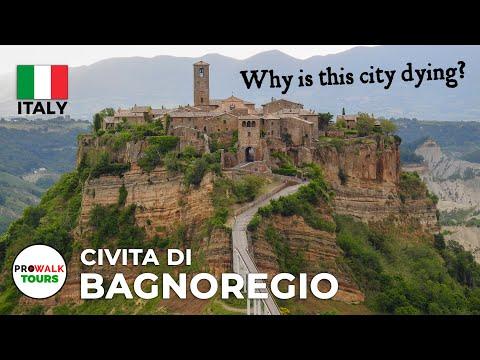Civita di Bagnoregio was never on my radar until I stumbled upon a travel blog detailing its ethereal charm. Situated in the Lazio region of Italy, this quaint village seemed like a picturesque relic from another era, suspended between time and space on a fragile plateau. I was captivated by its reputation as “The Dying Town,” and the thought of exploring it pulled me in with irresistible allure. Thus began my adventure through its ancient streets, a journey that would etch itself into my memory forever.
As I approached Civita di Bagnoregio, the first thing that struck me was its isolation. The town is perched atop a hill, surrounded by a valley of eroded tufa rock, which gives the area a surreal, otherworldly appearance. The access is limited to a pedestrian bridge, a narrow pathway suspended over the ravine, making the arrival to Civita feel like stepping into a different world entirely.
The bridge itself was an experience. It stretched precariously from the end of the paved road, offering tantalizing glimpses of the valley below. With every step I took, I felt the bridge sway slightly, and the view became more breathtaking. The town seemed almost otherworldly, its stone buildings glowing softly in the midday sun. The closer I got, the more I marveled at the ancient architecture, a testament to the resilience of a town that had weathered countless challenges over centuries.
Once I crossed the bridge, I was greeted by the sight of medieval buildings that seemed almost frozen in time. The narrow cobbled streets wound their way through the town like veins, each turn revealing charming little squares and hidden corners. The silence was profound, punctuated only by the distant clatter of my footsteps and the occasional murmur of a fellow traveler. Civita di Bagnoregio has a way of making you feel like an explorer in a forgotten world.
I decided to start my tour at the heart of the town: the Piazza San Donato. This central square is flanked by some of the town’s most significant buildings, including the Church of San Donato, which dates back to the 8th century. As I approached the church, I was struck by its simple yet elegant façade, a stark contrast to the elaborate churches found in other parts of Italy. Inside, the church exuded a serene atmosphere, with its modest interior offering a peaceful respite from the sunlit streets.
From the Piazza San Donato, I wandered through the narrow alleys, each one revealing a new facet of Civita di Bagnoregio’s charm. The architecture was a delightful mix of medieval and Renaissance styles, with stone houses adorned with ivy and flowers cascading from window boxes. I passed by small artisan shops selling handcrafted goods and local delicacies, the scent of fresh bread and local cheeses wafting through the air.
One of the most captivating aspects of Civita di Bagnoregio is its unique urban planning. The town is designed to be both defensible and picturesque, with its narrow streets and high walls providing a natural defense against invaders. The buildings themselves are constructed from local tufa stone, which not only gives the town its distinctive appearance but also contributes to its fragility. Erosion and time have taken their toll, and efforts are ongoing to preserve this remarkable place for future generations.
As I continued my exploration, I came across the old town gate, an imposing structure that once served as the primary entrance to Civita. Walking through the gate felt like passing through a portal to the past. The gate’s heavy wooden doors, reinforced with iron, seemed to hold countless stories within their aged planks. On the other side, I was greeted by more charming streets and quaint squares, each one offering a glimpse into the town’s rich history.
The highlight of my tour was a visit to the town’s Etruscan Museum. Housed in a historic building, the museum offers a fascinating insight into the ancient civilizations that once inhabited the region. Exhibits included pottery, sculptures, and artifacts that painted a vivid picture of life in the area thousands of years ago. I was particularly struck by the intricate jewelry and ceramics, which demonstrated the skill and artistry of the Etruscans.
After my museum visit, I decided to climb to the top of the town’s highest point, where a small lookout area offers panoramic views of the surrounding landscape. The climb was a bit strenuous, but the reward was well worth the effort. From the top, I could see the rolling hills of Lazio stretching out in every direction, with the lush greenery contrasting sharply with the stark, eroded valleys below. The view was breathtaking, a perfect way to cap off my exploration of this enchanting town.
As the day drew to a close, I reluctantly made my way back to the pedestrian bridge. The setting sun cast a golden hue over Civita di Bagnoregio, enhancing its already otherworldly beauty. The town seemed to glow with a warm, inviting light, a fitting end to my visit. Crossing the bridge one last time, I felt a deep sense of gratitude for having experienced this incredible place. Civita di Bagnoregio had offered me a rare glimpse into a world frozen in time, and as I left, I knew that the memories of my visit would stay with me for years to come.
